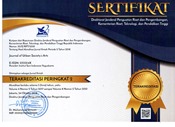Beyond Tweets: Pragmatic Analysis of Humor as a Brand Image in Burger King’s Tweets
Abstract
Melebihi Tweet: Analisis Pragmatis Humor sebagai Citra Merek di Tweet Burger King. Salah satu bentuk strategi komunikasi yang paling populer adalah humor. Meskipun berbagai penelitian telah dilakukan untuk meneliti hubungan humor dan semantik dalam konteks iklan, relatif sedikit yang telah membahas hubungan antara tweet humor, komunikasi bisnis, dan pragmatik. Oleh karena itu, tujuan utama dari penelitian ini adalah untuk (1) menyelidiki konstruksi tweet humor berdasarkan delapan sumber daya pengetahuan dan (2) membahas fungsi pragmatisnya. Penelitian ini menggunakan versi ekstensi dari Teori Umum Humor Verbal Attardo (Tsakona, 2013), dilengkapi dengan analisis fungsional teks Brinker. Dipilih berdasarkan style humor yang digunakan (Martin, 2003), data untuk penelitian ini terdiri dari 111 tweet humor dari akun Twitter Burger King antara tahun 2016 dan 2018. Tiga tahun dipilih karena tampaknya ada korelasi positif antara penggunaan strategi humor di media sosial dan kinerja penjualan Burger King selama tahun-tahun itu. Temuan utama adalah bahwa Burger King: (1) menerapkan konstruksi humor yang berbeda di akun Twitter Burger King, terutama dalam oposisi teks, mekanisme bahasa, target, dan konteks; dan (2) menggunakan fungsi tweet humor yang berbeda untuk mempersonalisasi merek (2016), meminta pelanggan untuk melakukan beberapa tindakan (2017), dan mempromosikan produk (2018).
One of the most popular forms of communication strategy is humor. Although various studies have accounted the relation of humor and semantics in advertisement context, relatively little has discussed the link between humor tweets, business communication, and pragmatics. Therefore, the main aim of this study is to (1) investigate the construction of humor tweets based on eight knowledge resources and (2) discuss its pragmatic function. The study applies the extension version of Attardo’s General Theory of Verbal Humor (Tsakona, 2013), complemented with Brinker’s text functional analysis. Selected based on style humor used (Martin et al., 2003), the data for the study consist of 111 humor tweets from Burger King Twitter account between the year 2016 and 2018. The three years are selected because there seems to be a positive corellation between the use of humor strategy in social media and Burger King’s sales during those years. A key finding is that Burger King: (1) applies different construction of humor in Burger King’s Twitter account, especially in Script Opposition, Language Mechanism, Target, and Context; and (2) uses different function of the humor tweets for personalizing the brand (2016), asking the customer to do some act (2017), and promoting the products (2018).
Keywords
Full Text:
PDFReferences
Adegoju, A., & Oyebode, O. (2015). Humour as discursive practice in Nigeria’s 2015 presidential election online campaign discourse. Discourse Studies, 17(6), 643–662. https://doi.org/10.1177/1461445615602378
Arhoj, T. (2011). A Linguistic Study on the Communication of the Corporate Identity based on Corporate Websites in Germany and Denmark : Is Congruity Possible ? (June). Retrieved from http://pure.au.dk/portal/files/45644426/McKinsey_and_Company_a_Linguistic_Study_of_the_Corporate_Website.pdf
Attardc, S., & Raskin, V. (1991). Script theory revis(it)ed: Joke similarity and joke representation model. Humor. https://doi.org/10.1515/humr.1991.4.3-4.293
Attardo, S. (2017). The routledge handbook of language and humor. In The Routledge Handbook of Language and Humor. https://doi.org/10.4324/9781315731162
Attardo, S., Hempelmann, C. F., & Di Maio, S. (2002). Script oppositions and logical mechanisms: Modeling incongruities and their resolutions. Humor. https://doi.org/10.1515/humr.2002.004
Burger King statistics and facts. (n.d.). In Statista. Retrieved from https://www.statista.com/topics/1460/burger-king/
Canestrari, C. (2010). Meta-communicative signals and humorous verbal interchanges: A case study. Humor. https://doi.org/10.1515/HUMR.2010.015
Canestrari, C., & Bianchi, I. (2014). From perception of contraries to humorous incongruities. https://doi.org/10.1075/thr.1.02can
Davis, J. L., Love, T. P., & Killen, G. (2018). Seriously funny: The political work of humor on social media. New Media and Society. https://doi.org/10.1177/1461444818762602
Eysenck, H. J. (2002). Personality and sense of humor. Personality and Individual Differences. https://doi.org/10.1016/0191-8869(85)90074-1
Hempelmann, C. F., & Ruch, W. (2005). 3 WD meets GTVH: Breaking the ground for interdisciplinary humor research. Humor. https://doi.org/10.1515/humr.2005.18.4.353
Hoicka, E. (2014). The Pragmatic Development of Humor. https://doi.org/10.1075/tilar.10.13hoi
Irazú, D., Farías, H., Rosso, P., & Patti, V. (2017). Irony and Sarcasm Detection in Twitter: The Role of Affective Content. (September). Retrieved from http://users.dsic.upv.es/~prosso/resources/IrazuHernandezPhD.pdf
Lalancette, M., & Raynauld, V. (2017). The Power of Political Image: Justin Trudeau, Instagram, and Celebrity Politics. American Behavioral Scientist. https://doi.org/10.1177/0002764217744838
Linden, H., & Linden, S. (2016). Fans and fan cultures: Tourism, consumerism and social media. In Fans and Fan Cultures: Tourism, Consumerism and Social Media. https://doi.org/10.1057/978-1-137-50129-5
Martin, R. A., Puhlik-Doris, P., Larsen, G., Gray, J., & Weir, K. (2003). Individual differences in uses of humor and their relation to psychological well-being: Development of the humor styles questionnaire. Journal of Research in Personality. https://doi.org/10.1016/S0092-6566(02)00534-2
Masaeli, B., & Heidari-Shahreza, M. A. (2016). A linguistic analysis of persian online Jokes in light of general theory of verbal humor. Journal of Applied Linguistics and Language Research, 3(7), 230–239.
Mullan, K., & Béal, C. (2018). Conversational humor in French and Australian English: What makes an utterance (un)funny? Intercultural Pragmatics. https://doi.org/10.1515/ip-2018-0016
Simon, S., & Dejica-Cartis, D. (2015). Speech Acts in Written Advertisements: Identification, Classification and Analysis. Procedia - Social and Behavioral Sciences, 192, 234–239. https://doi.org/10.1016/j.sbspro.2015.06.033
Tsakona, V. (2013). Okras and the metapragmatic stereotypes of humour: Towards an expansion of the GTVH. In Developments in linguistic humour theory.
Yliopisto, H. (2010). Twitter discourse: Hashtags as pragmatic markers. (September). Retrieved from https://helda.helsinki.fi/bitstream/handle/10138/168144/Laukkanen_Essi_ProGradu_2016.pdf?sequence=2
DOI: https://doi.org/10.24821/jousa.v6i1.2567
Refbacks
- There are currently no refbacks.

This work is licensed under a Creative Commons Attribution 4.0 International License. ISSN 2355-2131 (print) | ISSN 2355-214X (online).






